-
 Bitcoin
Bitcoin $85,667.5889
1.45% -
 Ethereum
Ethereum $1,645.0464
1.09% -
 Tether USDt
Tether USDt $0.9999
0.01% -
 XRP
XRP $2.1508
1.30% -
 BNB
BNB $589.4345
-0.06% -
 Solana
Solana $131.4976
-0.50% -
 USDC
USDC $0.9999
0.00% -
 TRON
TRON $0.2514
-1.73% -
 Dogecoin
Dogecoin $0.1601
-2.43% -
 Cardano
Cardano $0.6447
0.89% -
 UNUS SED LEO
UNUS SED LEO $9.4306
0.49% -
 Chainlink
Chainlink $12.7413
0.32% -
 Avalanche
Avalanche $20.0223
0.06% -
 Stellar
Stellar $0.2413
0.24% -
 Toncoin
Toncoin $2.9581
4.42% -
 Sui
Sui $2.2029
-2.07% -
 Shiba Inu
Shiba Inu $0.0...01196
-1.39% -
 Hedera
Hedera $0.1666
0.16% -
 Bitcoin Cash
Bitcoin Cash $335.2737
-1.78% -
 Litecoin
Litecoin $78.2670
0.57% -
 Polkadot
Polkadot $3.6968
1.17% -
 Hyperliquid
Hyperliquid $16.3661
2.35% -
 Dai
Dai $1.0000
0.00% -
 Bitget Token
Bitget Token $4.3524
2.42% -
 Pi
Pi $0.7432
-1.22% -
 Ethena USDe
Ethena USDe $0.9990
0.02% -
 Monero
Monero $212.4190
2.42% -
 Uniswap
Uniswap $5.4203
0.01% -
 OKB
OKB $52.2810
-1.31% -
 Pepe
Pepe $0.0...07441
0.12%
Does Trust Wallet support hardware wallets?
Trust Wallet supports Ledger and Trezor hardware wallets, enhancing security by keeping private keys offline while offering a user-friendly interface for managing cryptocurrencies.
Apr 08, 2025 at 10:21 am
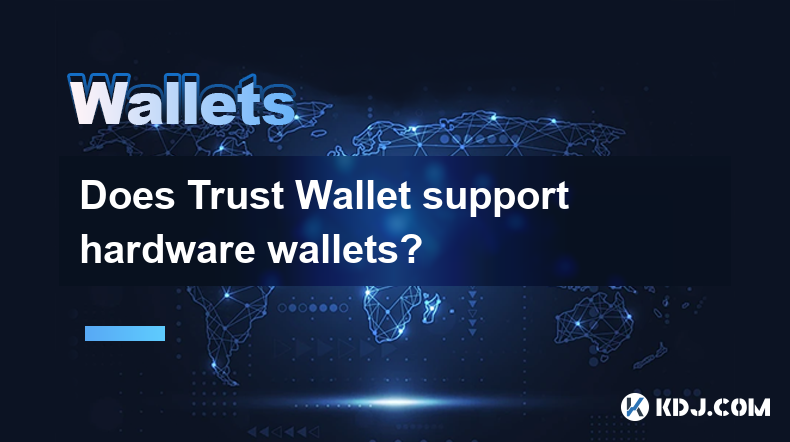
Trust Wallet, a popular cryptocurrency wallet, is known for its robust security features and user-friendly interface. One common question among users is whether Trust Wallet supports hardware wallets. Hardware wallets are physical devices that store private keys offline, offering an additional layer of security against online threats. In this article, we will explore the compatibility of Trust Wallet with hardware wallets, the steps to connect them, and the benefits of using such a setup.
What Are Hardware Wallets?
Hardware wallets are dedicated devices designed to securely store cryptocurrency private keys offline. Unlike software wallets, which are vulnerable to hacking and malware, hardware wallets keep your keys safe from online threats. Popular hardware wallets include Ledger, Trezor, and KeepKey. These devices typically connect to your computer or mobile device via USB or Bluetooth, allowing you to manage your cryptocurrencies while keeping your private keys offline.
Compatibility of Trust Wallet with Hardware Wallets
Trust Wallet does support hardware wallets, specifically the Ledger and Trezor devices. This compatibility enhances the security of your digital assets by allowing you to sign transactions on the hardware wallet itself, ensuring your private keys never leave the device. To use a hardware wallet with Trust Wallet, you need to ensure that your hardware wallet's firmware is up to date and that you have the latest version of Trust Wallet installed on your mobile device.
Steps to Connect a Hardware Wallet to Trust Wallet
To connect a hardware wallet to Trust Wallet, follow these steps:
- Download and install the latest version of Trust Wallet from the official website or app store.
- Connect your hardware wallet to your mobile device using a USB cable or Bluetooth, depending on the model.
- Open Trust Wallet and navigate to the settings menu.
- Select "Connect Hardware Wallet" and choose your device type (Ledger or Trezor).
- Follow the on-screen instructions to complete the connection process. This usually involves confirming the connection on your hardware wallet itself.
Benefits of Using a Hardware Wallet with Trust Wallet
Using a hardware wallet with Trust Wallet offers several advantages:
- Enhanced Security: By keeping your private keys offline, you significantly reduce the risk of theft or hacking.
- User-Friendly Interface: Trust Wallet's intuitive design makes it easy to manage your cryptocurrencies, even when using a hardware wallet.
- Compatibility: Trust Wallet supports multiple cryptocurrencies, allowing you to manage a diverse portfolio securely.
- Portability: Hardware wallets are small and easy to carry, making them ideal for managing your assets on the go.
How to Manage Cryptocurrencies with a Hardware Wallet in Trust Wallet
Once your hardware wallet is connected to Trust Wallet, you can manage your cryptocurrencies seamlessly. Here's how:
- View Your Balances: Trust Wallet displays your cryptocurrency balances directly from your hardware wallet.
- Send and Receive: You can send and receive cryptocurrencies using the hardware wallet's interface within Trust Wallet. Transactions are signed on the hardware wallet for added security.
- Staking and DApps: Some hardware wallets support staking and interaction with decentralized applications (DApps). Trust Wallet allows you to access these features while maintaining the security of your hardware wallet.
Troubleshooting Common Issues
While connecting a hardware wallet to Trust Wallet is generally straightforward, you may encounter some issues. Here are some common problems and their solutions:
- Connection Issues: Ensure that your hardware wallet is properly connected to your mobile device. If using Bluetooth, make sure it's paired correctly.
- Outdated Firmware: If your hardware wallet's firmware is outdated, it may not be compatible with Trust Wallet. Update your firmware to the latest version.
- App Version: Ensure you are using the latest version of Trust Wallet. Older versions may not support the latest hardware wallet features.
Security Considerations
When using a hardware wallet with Trust Wallet, it's essential to consider security best practices:
- Never Share Your Recovery Phrase: Your hardware wallet's recovery phrase should be kept secret and stored in a safe place. Never enter it into any online platform.
- Regularly Update Firmware: Keep your hardware wallet's firmware up to date to protect against known vulnerabilities.
- Use Strong Passcodes: Set a strong passcode for your hardware wallet and Trust Wallet to add an extra layer of security.
Additional Features and Future Developments
Trust Wallet continues to evolve, and future updates may include additional support for other hardware wallets and enhanced features for existing ones. Currently, Trust Wallet supports Ledger and Trezor, but as the cryptocurrency ecosystem grows, more hardware wallets may be integrated. Keep an eye on Trust Wallet's official announcements for the latest updates and new features.
User Experiences and Reviews
Many users have reported positive experiences using hardware wallets with Trust Wallet. The combination of Trust Wallet's user-friendly interface and the security provided by hardware wallets has been praised by the crypto community. Users appreciate the peace of mind that comes with knowing their private keys are stored offline, reducing the risk of theft or hacking. Reviews often highlight the ease of setup and the seamless integration between Trust Wallet and hardware wallets like Ledger and Trezor.
Comparison with Other Wallets
When considering whether to use Trust Wallet with a hardware wallet, it's helpful to compare it with other popular wallets that also support hardware wallets. Here's a brief comparison:
- MetaMask: While MetaMask supports hardware wallets, it is primarily a browser extension, which may not offer the same level of mobile accessibility as Trust Wallet.
- MyEtherWallet (MEW): MEW supports hardware wallets and is known for its focus on Ethereum, but it may not have the same breadth of cryptocurrency support as Trust Wallet.
- Exodus: Exodus offers a user-friendly interface and supports hardware wallets, but it may lack some of the advanced features and DApp integration found in Trust Wallet.
Educational Resources and Support
Trust Wallet provides various resources to help users understand how to use hardware wallets effectively. These include:
- Tutorials and Guides: Detailed step-by-step guides on connecting and using hardware wallets with Trust Wallet.
- FAQ Section: A comprehensive FAQ section addressing common questions and issues related to hardware wallet integration.
- Community Support: Access to a community of users and developers who can offer advice and troubleshooting tips.
Conclusion
Trust Wallet's support for hardware wallets like Ledger and Trezor enhances the security and usability of managing your cryptocurrencies. By following the steps outlined in this article, you can seamlessly integrate your hardware wallet with Trust Wallet, enjoying the benefits of offline key storage and a user-friendly interface. As the cryptocurrency landscape continues to evolve, Trust Wallet's commitment to security and user experience ensures that it remains a top choice for crypto enthusiasts.
Frequently Asked Questions
Q: Which hardware wallets are supported by Trust Wallet?
A: Trust Wallet supports Ledger and Trezor hardware wallets. Ensure that your hardware wallet's firmware is up to date for the best compatibility.
Q: How do I connect my hardware wallet to Trust Wallet?
A: To connect your hardware wallet to Trust Wallet, download and install the latest version of Trust Wallet, connect your hardware wallet to your mobile device, open Trust Wallet, navigate to the settings menu, select "Connect Hardware Wallet," choose your device type, and follow the on-screen instructions.
Q: What are the benefits of using a hardware wallet with Trust Wallet?
A: Using a hardware wallet with Trust Wallet enhances security by keeping your private keys offline, offers a user-friendly interface, supports multiple cryptocurrencies, and provides portability for managing your assets on the go.
Q: Can I manage all my cryptocurrencies with a hardware wallet in Trust Wallet?
A: Yes, once connected, you can view your balances, send and receive cryptocurrencies, and even stake or interact with DApps, all while maintaining the security of your hardware wallet.
Q: What should I do if I encounter issues connecting my hardware wallet to Trust Wallet?
A: Ensure your hardware wallet is properly connected, update your firmware and Trust Wallet app to the latest versions, and check the Trust Wallet support resources for troubleshooting tips.
Disclaimer:info@kdj.com
The information provided is not trading advice. kdj.com does not assume any responsibility for any investments made based on the information provided in this article. Cryptocurrencies are highly volatile and it is highly recommended that you invest with caution after thorough research!
If you believe that the content used on this website infringes your copyright, please contact us immediately (info@kdj.com) and we will delete it promptly.
- Galaxy Digital's $40M Ethereum Transfer Raises Eyebrows as Market Reacts
- 2025-04-15 16:00:12
- Publicly Listed Companies Increased Their Bitcoin Holdings by 16.1% in Q1 2025
- 2025-04-15 16:00:12
- Bitcoin Has Rebounded Spectacularly This Week, Trading Close to $85,000
- 2025-04-15 15:55:13
- Galaxy Digital Deposits 25,000 ETH, Raising Questions About Market Intentions
- 2025-04-15 15:50:12
- Mantra Has Just Gone Through A Crash That Has Wiped Out Most Of Its Value. Here's How On-Chain Metrics Have Changed During This Collapse.
- 2025-04-15 15:50:12
- Michael Saylor Does It Again: Strategy (Formerly MicroStrategy) Buys 3,459 BTC
- 2025-04-15 15:45:13
Related knowledge

How do I import MetaMask transaction history?
Apr 12,2025 at 07:35pm
Importing your MetaMask transaction history can be an essential task for managing your cryptocurrency activities. Whether you're looking to keep a record of your transactions for tax purposes or simply want to track your investment performance, understanding how to import your transaction history is crucial. In this article, we'll explore the detailed s...
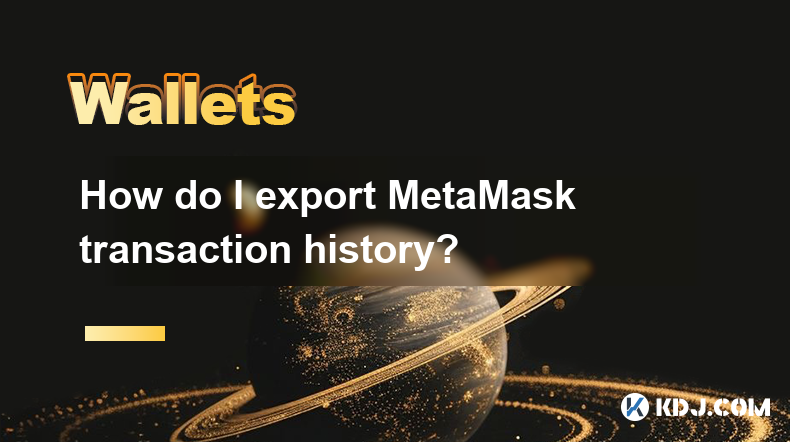
How do I export MetaMask transaction history?
Apr 14,2025 at 05:21am
Exporting your MetaMask transaction history can be a crucial task for keeping track of your cryptocurrency transactions, whether for personal records, tax purposes, or auditing. In this article, we will guide you through the process of exporting your MetaMask transaction history in a detailed, step-by-step manner. Understanding MetaMask Transaction Hist...

How do I verify a message signature in MetaMask?
Apr 14,2025 at 02:49am
Verifying a message signature in MetaMask is a crucial skill for anyone involved in the cryptocurrency space, especially when it comes to ensuring the authenticity and integrity of communications. This process allows you to confirm that a message was indeed signed by the owner of a specific Ethereum address. In this article, we will walk you through the...
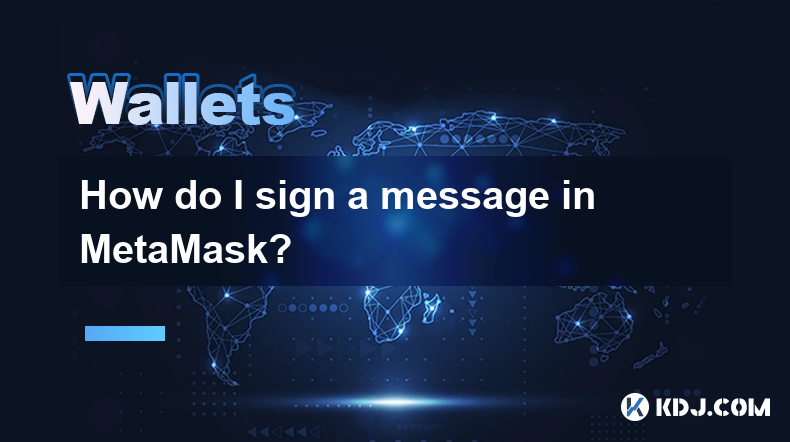
How do I sign a message in MetaMask?
Apr 12,2025 at 08:49pm
Introduction to Message Signing in MetaMaskMessage signing is a crucial feature in the world of cryptocurrencies, particularly when using wallets like MetaMask. It allows users to prove ownership of their wallet address without transferring any funds. This process involves generating a unique signature using your private key, which can then be verified ...
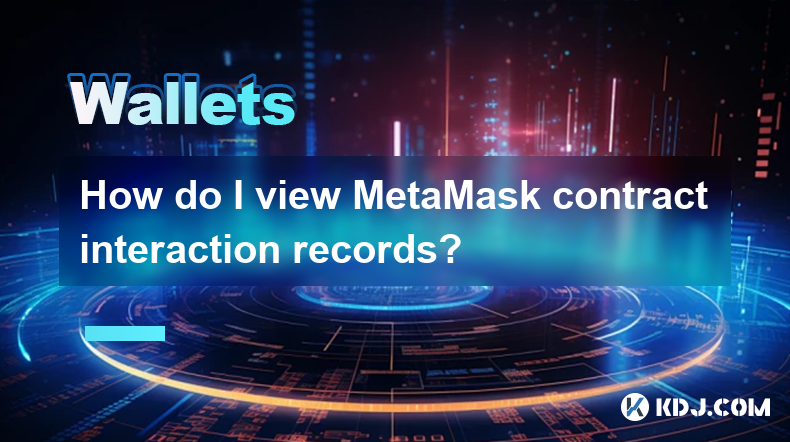
How do I view MetaMask contract interaction records?
Apr 13,2025 at 02:35am
Introduction to MetaMask and Contract InteractionsMetaMask is a popular cryptocurrency wallet that allows users to interact with the Ethereum blockchain and other compatible networks. One of the key features of MetaMask is the ability to interact with smart contracts, which are self-executing programs stored on the blockchain. These interactions can inc...
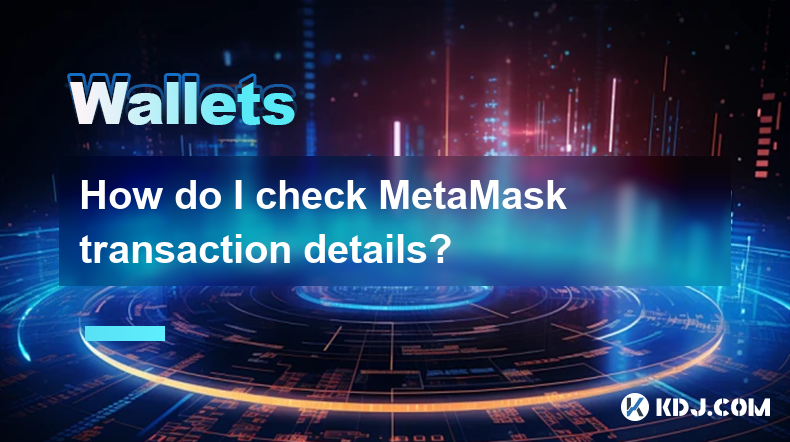
How do I check MetaMask transaction details?
Apr 15,2025 at 02:35pm
Checking MetaMask transaction details is an essential skill for anyone using this popular cryptocurrency wallet. Whether you're tracking a recent transaction, verifying its status, or troubleshooting issues, understanding how to access and interpret transaction details can help you manage your crypto assets effectively. In this article, we'll walk you t...

How do I import MetaMask transaction history?
Apr 12,2025 at 07:35pm
Importing your MetaMask transaction history can be an essential task for managing your cryptocurrency activities. Whether you're looking to keep a record of your transactions for tax purposes or simply want to track your investment performance, understanding how to import your transaction history is crucial. In this article, we'll explore the detailed s...

How do I export MetaMask transaction history?
Apr 14,2025 at 05:21am
Exporting your MetaMask transaction history can be a crucial task for keeping track of your cryptocurrency transactions, whether for personal records, tax purposes, or auditing. In this article, we will guide you through the process of exporting your MetaMask transaction history in a detailed, step-by-step manner. Understanding MetaMask Transaction Hist...

How do I verify a message signature in MetaMask?
Apr 14,2025 at 02:49am
Verifying a message signature in MetaMask is a crucial skill for anyone involved in the cryptocurrency space, especially when it comes to ensuring the authenticity and integrity of communications. This process allows you to confirm that a message was indeed signed by the owner of a specific Ethereum address. In this article, we will walk you through the...

How do I sign a message in MetaMask?
Apr 12,2025 at 08:49pm
Introduction to Message Signing in MetaMaskMessage signing is a crucial feature in the world of cryptocurrencies, particularly when using wallets like MetaMask. It allows users to prove ownership of their wallet address without transferring any funds. This process involves generating a unique signature using your private key, which can then be verified ...

How do I view MetaMask contract interaction records?
Apr 13,2025 at 02:35am
Introduction to MetaMask and Contract InteractionsMetaMask is a popular cryptocurrency wallet that allows users to interact with the Ethereum blockchain and other compatible networks. One of the key features of MetaMask is the ability to interact with smart contracts, which are self-executing programs stored on the blockchain. These interactions can inc...

How do I check MetaMask transaction details?
Apr 15,2025 at 02:35pm
Checking MetaMask transaction details is an essential skill for anyone using this popular cryptocurrency wallet. Whether you're tracking a recent transaction, verifying its status, or troubleshooting issues, understanding how to access and interpret transaction details can help you manage your crypto assets effectively. In this article, we'll walk you t...
See all articles























































































